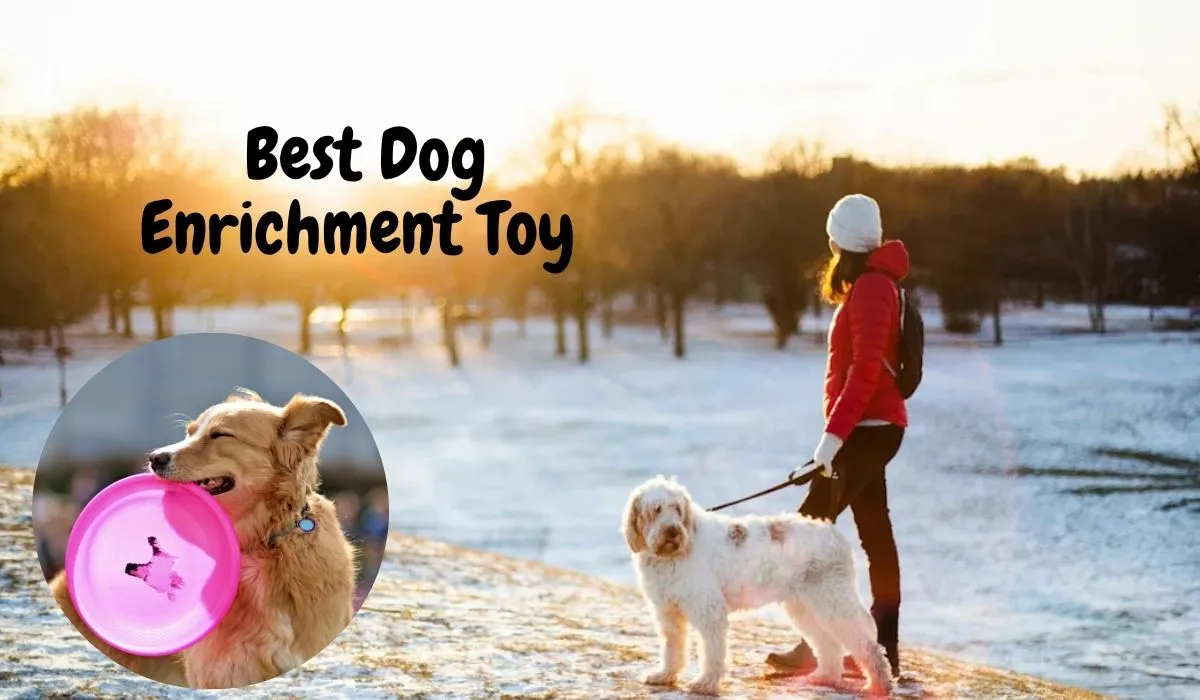When the temperature drops and the days get shorter, it's tempting to curl up on the couch and let your dog's exercise routine fall by the wayside. But your furry friend's needs don't change with the seasons!
Winter is not a limitation; it's an opportunity. It's your chance to get creative and discover new ways to engage your Dog enrichment toys. A stimulated dog is a happy dog, and a happy dog makes for a peaceful home. This comprehensive guide will walk you through fun, easy ways to exercise your dog's mind, body, and spirit, turning a potentially boring season into a bonding adventure you'll both love.
Why Winter Enrichment is Non-Negotiable for Dog Owners
A bored dog with pent-up energy is a recipe for trouble. We've all seen it: the chewing, the barking, the restless pacing. This isn't "bad behavior"—it's a cry for help from a dog whose needs aren't being met.
Providing consistent indoor stimulation is crucial for:
-
Preventing Boredom & Destructive Habits: Chewing shoes or digging at carpets are often signs of a dog that needs more mental challenges.
-
Maintaining a Healthy Weight: With fewer long walks, we must find alternative ways to help our dogs burn calories indoors.
-
Strengthening Your Bond: The games and training you do inside build trust and communication.
-
Supporting Overall Wellbeing: Mental exercise is just as tiring as physical exercise. A good brain workout can lead to a calm, content pup.
A Quick Safety Note: Every dog is unique! Always consult your veterinarian before starting new, strenuous physical activities, especially if your dog has existing health conditions.
Mental Gymnastics: Brain Games to Challenge Your Canine
Think of mental stimulation as a workout for your dog's brain. Canine enrichment activities are designed to make your dog think, problem-solve, and use their natural instincts. Just 15 minutes of a brain game can be as exhausting as a 30-minute walk!
Harnessing Your Dog's Incredible Nose: Scent Work Games
Your dog's sense of smell is their most powerful tool. Indoor scent games are a fantastic low-energy way to provide deep mental satisfaction.
-
The "Find It" Game: Start by having your dog "stay." Show them a high-value training treat, then hide it in an easy-to-find spot. Release them with a joyful "Find it!" As they improve, increase the difficulty.
-
The Muffin Tin Game: Take a muffin tin, place a few treats in random cups, and cover all the cups with tennis balls. Your dog must figure out how to remove the balls to find the rewards.
Puzzle Power: The Best Interactive Dog Toys
Interactive dog toys are designed to dispense food or treats when your dog manipulates them correctly. They are a cornerstone of indoor dog enrichment.
-
Snuffle Mats: These fantastic mental stimulation toys are covered in fabric strips that create a grassy texture. Simply sprinkle your dog's healthy dry dog food or some natural training treats into the mat, and let them use their nose to forage for their entire meal.
-
Puzzle Toys & Treat Balls: From simple slider puzzles to complex multi-step boards, these toys require your dog to flip, slide, and nudge components to reveal the hidden healthy dog treats. They are perfect for building canine cognitive skills.
You may also read :- How Pets Help Children Grow: Top Benefits for Child Development
Winter Dog Activities: Keeping Your Dog Physically Fit
While mental workouts are vital, your dog still needs to move their body! Burning off excess energy during the winter months is key to a harmonious household.
Creative Canine Cardio: Indoor Exercise Ideas
You don't need a large space to get your dog's heart pumping.
-
Stairway Repeats: If you have a safe, carpeted staircase, this is a great workout. Have your dog sit at the bottom, then toss a favorite toy or a treat to the top. Ensure they come down slowly and carefully to avoid injury.
-
Tunnel Vision: Create a makeshift agility course using couch cushions, chairs, and blankets to form tunnels. Guide your dog through with encouragement and rewards.
-
Controlled Treadmill Walks: With proper training and extreme caution, a human treadmill can be used for indoor dog exercise. Always start slow, never leave your dog unattended, and use a harness for safety.
Interactive Play Sessions for Energy Burn
Turn playtime into a structured workout that also reinforces obedience.
-
The Flirt Pole: Imagine a giant cat toy, but built tough for dogs! A flirt pole has a lure on the end of a rope and pole, letting you simulate a thrilling chase game in a small space. It's excellent for teaching impulse control as you can ask for a "sit" or "down" before releasing them to chase.
-
Tug-of-War: A classic game of tug with a durable rope toy is a brilliant way to burn energy and build strength. The key is to teach rules, like "drop it" on command, to keep the game safe and fun.
-
Hallway Fetch: A long hallway is the perfect venue for a game of fetch when the yard is off-limits. Use a soft, lightweight ball to protect your home.
Nurturing the Spirit: Deepening Your Bond With Your Dog
"Spiritual" stimulation for dogs is all about fulfilling their core instincts and strengthening your emotional connection. It's about making them feel secure, loved, and purposeful.
The Joy of Chewing: A Natural Canine Instinct
Chewing is a deeply self-soothing behavior for dogs. Providing appropriate outlets is a form of emotional enrichment for dogs.
-
Stuffed Kong Toys & Toppls: These are arguably the best dog toys for mental stimulation. Fill them with a mixture of your dog's premium puppy food, wet food, peanut butter (xylitol-free!), or mashed banana, then freeze it. This creates a long-lasting, engaging challenge that keeps them busy and happy.
The Power of Positive Reinforcement Training
Training isn't just about commands; it's a conversation between you and your dog. Spending 5-10 minutes a day teaching a new trick or practicing old ones provides massive mental and spiritual stimulation.
-
Teach a New Trick: "Spin," "shake," or "play dead" are fun options.
-
Practice "Relaxation Protocol": This involves teaching your dog to settle on a mat amidst distractions, promoting incredible calmness.
Cozy Cuddle Time: The Simplest Stimulation
Never underestimate the power of simple, quiet connection. Grooming your dog, giving them a gentle massage, or just sitting together while you pet them fulfills a deep social need. This is the ultimate way to stimulate your dog's spirit and reassure them they are a cherished member of the family.
Fueling the Fun: The Role of Nutrition in Winter
Activity and nutrition go hand-in-paw. Using part of your dog's daily food allowance for games is a great way to prevent overfeeding.
-
Use Their Kibble: Instead of feeding from a bowl, use your dog's regular high-quality dog food as rewards in training sessions and puzzle toys.
-
Choose Healthy Treats: When you do use treats, opt for small, natural dog treats that are low in calories. You can even use healthy human foods like small pieces of carrot, apple (no seeds!), or plain, cooked chicken.
Winter Won't Know What Hit It!
This winter, you have a powerful toolkit to ensure your dog thrives. By mixing brain games, creative indoor exercises, and bonding activities, you're doing more than just passing the time—you're enriching your dog's life in a profound way.
So, embrace the cold as a chance to connect. Break out the Kong, lay down the snuffle mat, and get ready for a season of fun that will keep your dog's tail wagging until the spring thaw.
Frequently Asked Questions
Q1: My dog doesn't seem interested in puzzle toys. What should I do?
Start super easy! Make the treats very visible and easy to get. Use incredibly high-value rewards like tiny pieces of hot dog or cheese. Praise them enthusiastically for any interaction with the toy to build their confidence.
Q2: How much mental stimulation does my dog need?
This varies by breed, age, and individual dog. A high-energy working breed like a Border Collie may need over an hour of combined physical and mental activity daily, while a senior dog might be content with 20-30 minutes. Watch your dog's behavior—restlessness often indicates a need for more stimulation.
Q3: Are there specific dog breeds that need more indoor mental stimulation?
Yes. Herding breeds (Border Collies, Australian Shepherds), sporting breeds (Labradors, Spaniels), and working breeds (German Shepherds, Huskies) are particularly prone to boredom and need consistent mental challenges, especially when stuck indoors.
Q4: Can these activities help with my dog's anxiety?
Absolutely! Mental stimulation and chewing are natural stress-relievers for dogs. A tired, mentally satisfied dog is less likely to exhibit anxiety-based behaviors.






